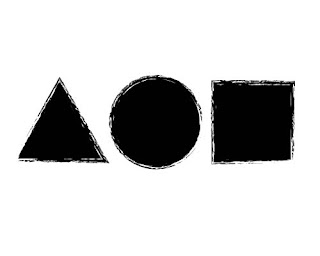The closures you generate between shapes can increase the time a viewer looks at your painting. You can create a slight tension that encourages a viewer to keep looking. Sometimes you will find it in life, inherent in your subject, or within your frame over view. Other times you must to engineer it or build it in. But ignorance or lack of closure will also do the opposite. Make the viewer move on quickly.
But what is Visual Closure? And how can an artist learn to see and play with it?
Let's look at three basic shapes, a triangle, a circle, and a square:
Now let's show what visual closure is by demonstrating one way it might be used – by using two shape to imply the existence of a third:
1. Note the circle and square are not completely expressed but spring forth from your own assumptions.
2. Note that you perceive the third shape as a triangle, because your brain recognizes two parts and fills in the rest.
3. Since I haven't drawn any shape in its entirety the final image exist in your mind and not on paper.
4. So visual closure means you, the viewer, are allowed to participate in creating the image. And when it works you feel satisfied.
Isn't that nice?
But, as our (implied) circle and square move farther apart the (implied) triangle becomes weaker, and more becomes required from the viewer to complete it. That isn't necessarily a bad thing, as sometimes the artist might want to create a weaker sense of closure, against a stronger one, but if an artist wishes to create a sense of closure then he or she must be careful about how far to push it.
And finally, here is a demonstration of how multiple visual closures may be used to lead the eye through a composition. My point being, if you offer your viewers an interesting and satisfying assortment of closures you will keep their eyes moving around your painting. Your audience will enjoy exploring your painting again and again, over a longer period of time. They will also consciously or unconsciously feel more ownership over your painting because they are the ones assembling the image in their own mind, not you.
And that's a good thing, right?
Look for how Visual Closure has been used in any great work of art, from any historical period, ancient to modern. If you do I am confident you will learn to see it in life as well!
-----
Tomorrow I leave for the first of many plein air painting invitationals, the 2011 Carmel Art Festival. I'll try to upload one or more images a day to the blog so if you want to follow along, come back often or subscribe in the field above and receive my postings in your email box. they will be quick snaps, from my phone, because I will be leaving my laptop at home.






2 reader comments:
Isn't this concept interesting? I think I remember it being presented in basic design classes as the 'Gestalt theory'. Not sure if that is it, but regardless a great post to refresh the memory.
Wishing you tons of success in the coming week. Break a leg!
HI Brenda. Thank you for your kind comments. I just re-read this post and feel a need to edit it for clarity, if not a simpler sentence structure. Sometime I hit upload too soon...
And not to go all pedantic, but IMHO Gestalt Perception is something apart from closure, and certainly worth its own post. So thanks for prompting that too.
Post a Comment